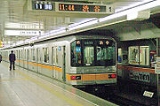
Tokyo Metro 01 series
Encyclopedia
The is an electric multiple unit
type operated by Tokyo Metro
on the Tokyo Metro Ginza Line
subway in Tokyo, Japan. A total of 38 six-car trainsets were introduced from 1983. It was the recipient of the 25th Laurel Prize of the Japan Railfan Club in 1985. A total of 228 cars were built from 1983 to 1997 in five batches.
These trains use a Train Automatic Stopping Controller
(TASC) system allowing them to automatically stop at stations.
The 02 series
used on the Marunouchi Line is based on the 01 series.
The 01 series trains are scheduled to be replaced by new 1000 series
trains from spring 2012, with the entire fleet replaced by fiscal 2015.
Electric multiple unit
An electric multiple unit or EMU is a multiple unit train consisting of self-propelled carriages, using electricity as the motive power. An EMU requires no separate locomotive, as electric traction motors are incorporated within one or a number of the carriages...
type operated by Tokyo Metro
Tokyo Metro
is one of two rapid transit systems making up the Tokyo subway system, the other being Toei. It is the most used subway system in the world in terms of annual passenger rides.-Organization:...
on the Tokyo Metro Ginza Line
Tokyo Metro Ginza Line
The is a subway line located in Tokyo, Japan. It is part of the of Tokyo Metro network. The official name is . It is 14.3 km long and serves the wards of Shibuya, Minato, Chūō, Chiyoda, and Taitō....
subway in Tokyo, Japan. A total of 38 six-car trainsets were introduced from 1983. It was the recipient of the 25th Laurel Prize of the Japan Railfan Club in 1985. A total of 228 cars were built from 1983 to 1997 in five batches.
These trains use a Train Automatic Stopping Controller
Train Automatic Stopping Controller
A Train Automatic Stopping Controller , also known as a , is a train protection system used only in Japan. It allows trains equipped with TASC to stop automatically at stations without the need to operate the brakes manually....
(TASC) system allowing them to automatically stop at stations.
The 02 series
Tokyo Metro 02 series
The is an electric multiple unit type operated by Tokyo Metro on the Tokyo Metro Marunouchi Line in Tokyo, Japan. Its design is based on the Tokyo Metro 01 series.A total of 336 cars were introduced into service from 17 October 1988...
used on the Marunouchi Line is based on the 01 series.
The 01 series trains are scheduled to be replaced by new 1000 series
Tokyo Metro 1000 series
The is an electric multiple unit train type on order by Tokyo Metro in Japan for use on the Tokyo Metro Ginza Line from spring 2012.The first trainset was delivered in September 2011 ahead of entry into revenue service from spring 2012, with full-production sets entering service from 2013...
trains from spring 2012, with the entire fleet replaced by fiscal 2015.

